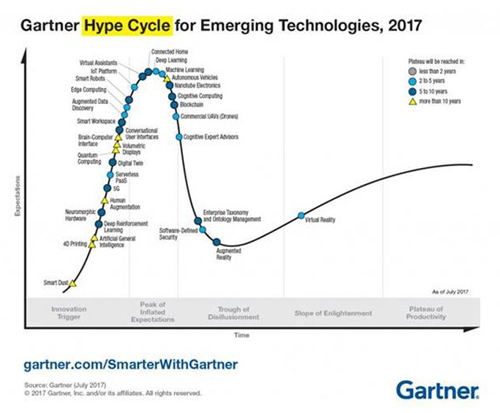
Gartner’s Hype Cycle places emerging technology on a hype line plotting the variation of users’ expectations over time. The technology then moves by stages, from users’ first realisation of its potential to solve problems, through to a period of over-inflated expectation.
This is followed by a period of rapid disillusionment - and finally a gradual steady and much slower rise in expectations and recovery as industries learn the serious and effective uses of the technology.
The technology becomes mature when it arrives on the plateau of productivity (see chart below).

Source: Gartner, Inc
In 2017 when Chris Ballinger was part of the Toyota Research Institute creating a series of proof of concept projects around blockchain, Gartner placed blockchain as having peaked in terms of the expectations and was descending rapidly into the trough of disillusionment that follows.
Delegates may be forgiven for recognising this pattern from their raised expectations after hearing speakers who have enthused about the potential of blockchain without really understanding the industry to which they were seeking to encourage its application.
Presentation from an auto-finance insider
Chris Ballinger, blockchain speaker at the next IAFN Conference and Awards in London on 13th September, definitely does not fit into this mould.
Ballinger is an auto finance insider with a lifetime of experience in how the auto industry actually works. He started out as a senior vice president at Bank of America, before joining Toyota Financial Services, helping to steer the business through the financial meltdown of the late 2000s; before finally becoming the Chief Innovation Officer, then head of mobility Services at the Toyota Research Institute and latterly starting MOBI, a mobility open blockchain initiative where he is chairman.
Ballinger’s knowledge of the industry may prove key to an industry seeking to transform itself through the use of emerging technologies.
He sees sharing data as key to the development of solutions which could transform and improve people’s lives. Blockchain provides a mechanism to enable this sharing in a controlled way.
It is important to consider what type of world we wish to build, Ballinger argues.
If we want a world in which mobility is not dominated by a single, or a handful of players, we need a platform which will enable the growth of an ecosystem around mobility data.
If we want a world in which drivers feel safe to share their asset usage data with mobility providers then we need to establish a platform which has built in controls over how that data is used.
Blockchain offers such a platform.
Perhaps Ballinger’s most startling example lies in blockchain’s potential use to help accelerate the pace of development of autonomous cars.
At present around 1.2 million people die each year in road traffic accidents. This can be reduced fast through the development of autonomous safer vehicles. The limiting factor in the pace of development is not the sophistication of sensors in the car, but the availability of sufficient quantities of data which AI systems can use to learn.
If auto companies were to pool their data, rather than to see it as their competitive advantage, then we would start to save those 1.2 million lives earlier.
Ballinger’s block chain presentation at the IAFN conference will provide a strategic understanding of the importance of blockchain, as well as some concrete examples of its use to transform auto finance.
If you are an IAFN delegate seeking to reach the plateau of productivity then book your place now to the IAFN conference. Chris Ballinger’s presentation is yet another which you cannot afford to miss.
Powered by Bizzabo
